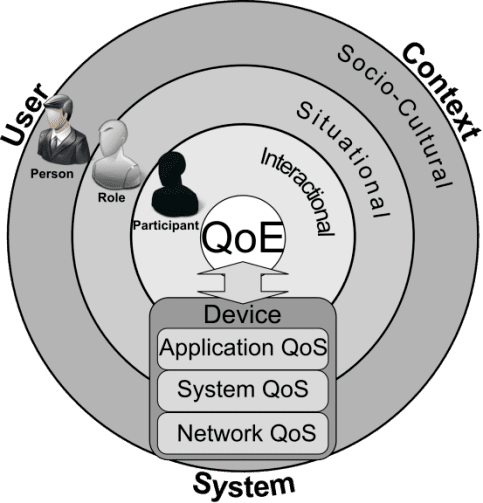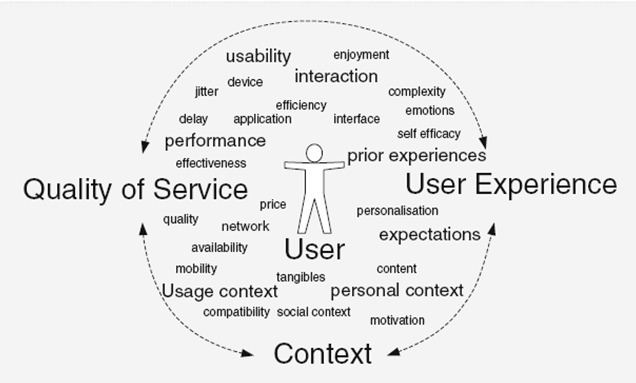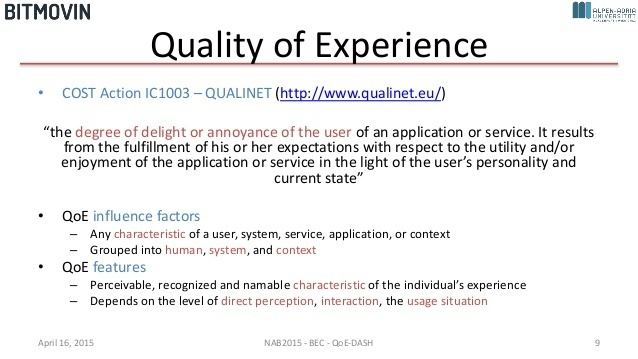 | ||
Online video quality of experience qoe
Quality of Experience (QoE, QoX or simply QX) is a measure of a customer's experiences with a service (web browsing, phone call, TV broadcast, call to a Call Center). QX focuses on the entire service experience, and is a more holistic evaluation than the more narrowly focused user experience (focused on a software interface) and customer-support experience (support focused).
Contents
- Online video quality of experience qoe
- Part 1 quality of service and quality of experience hd
- Telecommunications and Multimedia
- QoE Factors
- QoE in End To End Transmission Chains and Network Management
- Medical
- References

QoE looks at a vendor's or purveyor's offering from the standpoint of the customer or end user, and asks, "What mix of goods, services, and support, do you think will provide you with the perception that the total product is providing you with the experience you desired and/or expected?" It then asks, "Is this what the vendor/purveyor has actually provided?" If not, "What changes need to be made to enhance your total experience?" In short, QoE provides an assessment of human expectations, feelings, perceptions, cognition and satisfaction with respect to a particular product, service or application.

QoE is a fast emerging multidisciplinary field based on social psychology, cognitive science, economics, and engineering science, focused on understanding overall human quality requirements. QoE is the blueprint of all human quality needs and expectations. Traditionally, technology-centric approaches based on QoS parameters have been employed to ensure service quality to end users. QoE expands this horizon to capture people’s aesthetic and even hedonic needs.

QoE is a blueprint of all human subjective and objective quality needs and experiences arising from the interaction of a person with technology and with business entities in a particular context. Although QoE is perceived as subjective, it is the only measure that counts for customers of a service. Being able to measure it in a controlled manner helps operators understand what may be wrong with their services.

Part 1 quality of service and quality of experience hd
Telecommunications and Multimedia
QoE in the context of telecommunications networks is defined as:
The degree of delight or annoyance of the user of an application or service. It results from the fulfillment of his or her expectations with respect to the utility and / or enjoyment of the application or service in the light of the user’s personality and current state.
QoE is related to but differs from Quality of Service (QoS), which attempts to objectively measure service parameters (such as packet loss rates or average throughput). QoS measurement is most of the time not related to a customer, but to the media or network itself. QoE is a purely subjective measure from the user’s perspective of the overall value of the service provided.
QoE Factors
QoE cannot simply be taken as the effective quality of the service but must also take into consideration every factor that contributes to overall user's perceived quality. This includes system, human and contextual factors. These factors include the user’s terminal device (for example Low Definition or High Definition TV), their environment (in the car or at home), their expectations (cellular or corded telephone), the nature of the content and its importance (a simple yes/no message or an orchestral concert). The Mean Opinion Score (MOS) used for assessing the quality of telephone connections is a limited form of QoE measurement process, relating to a specific media type, in a controlled environment and without specific user expectations. The MOS as an indicator of experienced quality has not only been used for audio and speech communication, but has been expanded to assess the quality of television and multimedia signals.
QoE in End-To-End Transmission Chains and Network Management
As an important measure of the end-to-end performance at the services level from the user's perspective the QoE is an important metric for the design of systems and engineering processes. This is particularly relevant for video services because bad network performance may highly affect the user's experience. So, when designing systems the expected output, i.e. the expected QoE, is often taken into account also as a system output metric.
This QoE metric is often measured at the end devices and can conceptually be seen as the remaining quality after the distortion introduced during the preparation of the content and the delivery through the network until it reaches the decoder at the end device. There are several elements in the video preparation and delivery chain and some of them may introduce distortion. This causes the degradation of the content and several elements in this chain can be considered as "QoE relevant" for video services. These are the encoding system, transport network, access network, home network and end device.
In light of the above, several QoE-centric network management solutions have been proposed, which aim to improve the QoE delivered to the end-users. In this perspective, network resources and multimedia services are managed in order to guarantee specific QoE levels instead of classical QoS parameters, which are unable to reflect the actual delivered QoE. A pure QoE-centric management is challenged by the nature of the Internet itself, as the Internet was not originally designed to support today's complex and high demanding multimedia services. As an example, network nodes can become QoE-aware by estimating the status of the multimedia service as perceived by the end-users. This information can then be used to improve the delivery of the multimedia service over the network and proactively improve the users' QoE.
The concept of QoE in engineering is also known as Perceived Quality of Service (PQoS), in the sense of the QoS as it is finally perceived by the end-user. The evaluation of the PQoS for audiovisual content will provide a user with a range of potential choices, covering the possibilities of low, medium or high quality levels. Moreover the PQoS evaluation gives the service provider and network operator the capability to minimize the storage and network resources by allocating only the resources that are sufficient to maintain a specific level of user satisfaction.
Another approach for measuring QoE in video content is using a referenceless analysis. In this case, the QoE is not measured comparing an original video to delivered one, but by trying to detect artifacts such as blockiness, blur or jerkiness directly in the video. This approach is based on the idea that customers don't know the original content.
The evaluation of the PQoS is a matter of objective and subjective evaluation procedures, each time taking place after the encoding process (post-encoding evaluation). Subjective quality evaluation processes (PQoS evaluation) require large amount of human resources, establishing it as a time-consuming process. Objective evaluation methods, on the other hand, can provide PQoS evaluation results faster, but require large amount of machine resources and sophisticated apparatus configurations. Towards this, objective evaluation methods are based and make use of multiple metrics.
Medical
In medical terminology QoE is also known as "Quality of Patient Experience," and is a subjective measure of a patient's experiences with a medical practice. It looks at a care provider's offering from the standpoint of the patient's holistic experience, and asks, "How did patient fare after the treatment was concluded over an extended period of time? Did they enjoy a higher, similar, or lower quality of life after the treatment? For how long? How did this patient's quality of life, post-treatment compare with other patients who received similar treatment" And then asks, "What changes need to be made to the treatment to enhance the patient's quality of life?"
